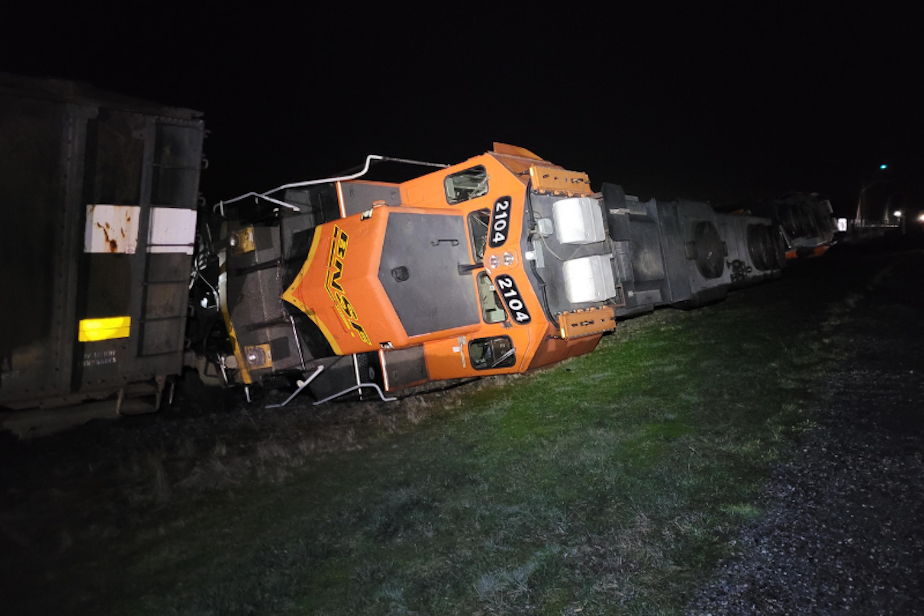Safety device, human error derailed Anacortes train, federal officials say

The Federal Railroad Administration has confirmed KUOW reporting that a safety device meant to keep trains from plunging into Puget Sound knocked a train off the tracks and onto the Swinomish Reservation early Thursday morning.
The short, seven-car BNSF Railway train was approaching a swinging bridge over the Swinomish Channel after leaving an oil refinery in Anacortes.
The bridge swings open to let boats through the Swinomish Channel, a shallow, 11-mile long arm of Puget Sound that connects Padilla Bay to Skagit Bay.
Devices called “derailers” (or just “derails”) sit on either side of the bridge, embedded in the railroad tracks, to force trains off the tracks when the bridge is open.
Thursday morning, the bridge was properly lined up for the train to cross it, but at least one derailer was still in operation.
The train’s wheels hit the steel-wedge device, and the two engine cars in front toppled to the right, plowing to a stop on their sides in the dirt next to an RV park and casino before reaching the bridge.
Sponsored
State officials estimate the engine cars spilled up to 3,100 gallons of diesel from their fuel tanks. They said, because the train fell to the right, none of the spilled diesel reached Puget Sound, on the left side of the track.
RELATED: Oil train derailed to avoid plunging into Puget Sound, tribal leader says
“There was a miscommunication between the train crew and the bridge tender,” said Federal Railroad Administration spokesperson Warren Flatau.
He said it appeared that neither the BNSF bridge tender nor the two-person BNSF train crew followed procedures.
“The person on the ground didn’t do everything he was supposed to do,” Flatau said.
Sponsored
Derailer devices usually have a bright-colored flag jutting up from the tracks when they are deployed.
“The train crew’s supposed to be paying attention to that,” he said.
BNSF Railway spokesperson Lena Kent declined to comment.
“It does appear that there was a miscommunication between the crew and the bridge tender regarding the lining of the bridge and lowering of the derails,” Herb Krohn with the International Association of Sheet Metal, Air, Rail and Transportation Workers said in an email. The union represents BNSF engineers and conductors.
Krohn said the train’s engineer had “many years of experience.”
Sponsored
Human error and poor track conditions are the leading causes of rail accidents in the United States, according to Federal Railroad Administration data.
Given the spill’s location on a tribal reservation, the Federal Railroad Administration sent an official to the site to monitor its cleanup but is not conducting a full investigation, Flatau said.
The wreck of the short train, with no injuries, fire, or explosion, did not meet the agency’s threshold to conduct a full investigation, he said. That’s even though thousands of gallons of diesel, a hazardous material, spilled onto the ground and into the groundwater beneath the Swinomish Reservation.
Flatau said the agency does not consider diesel to be a hazardous material unless it's part of a train's cargo.
At least 44 million tons of hazardous material moves on rail through Washington state each year, according to the U.S. Bureau of Transportation Statistics.
Sponsored
Samish Indian Nation chair Tom Wooten, who was briefed by officials at the crash scene, first told KUOW about the derailer device knocking the two locomotives over. A third, empty railcar partially derailed, while four tanker cars, also empty, stayed on the tracks.
“It's actually a designed function of that rail system to keep the train from plummeting off the end into the water, right, when the bridge is not aligned for the railroad to use,” Wooten said.
“It looks like the bridge tender screwed up by not deactivating the derailer,” Omaha-based rail-accident investigator Russell Quimby said in an email.
"A train derailing device seems to be a very 1890s solution,” Ken McClow of Granite Falls, Washington, commented on KUOW’s Facebook page. “Maybe ask Google if the bridge is open or closed before dumping a train off the tracks and polluting the ground. Seriously. Sensors, cameras, internet. I’ve got cameras and sensors in my house to tell me if the water is leaking, if a door is open. It’s not difficult."
“Derailers may sound ‘old school’ but they are obviously very effective and are designed to prevent much bigger catastrophes,” Quimby said. “Generally at low speeds, derailers just derail without putting rail vehicles on their sides.”
Sponsored
Since 2020, major rail lines in the United States have had a more modern system known as “positive train control” to keep trains from speeding or running into obstacles including other trains.
That system is required on railroads’ main lines but not minor branch lines.
State and federal politicians have been pushing for other safety improvements on the nation’s rails, especially since a train carrying hazardous materials spilled vinyl chloride and other carcinogens near the town of East Palestine, Ohio, in February.
“Unfortunately, a lot of this stuff doesn't get improved until accidents happen,” Samish chair Tom Wooten said.
On Wednesday, Washington Democratic Sen. Maria Cantwell chaired a U.S. Senate hearing on improving rail safety nationwide.
“We have to have minimum safety standards. We have to have modernization of safety technology,” Cantwell said.
By Saturday, crews at the Swinomish Reservation spill site had removed 2,100 cubic yards of contaminated soil—about 175 dump-truck loads—and 4,300 gallons of contaminated groundwater, according to agencies responding to the spill.
Responders planned to install a series of “sparging” wells that pump air underground to speed the evaporation of volatile petroleum products left in the groundwater. Vacuum trucks would then suck the petroleum vapors out of the ground.
Officials say no impacts to human health, fish, or wildlife have been observed from the spill.
According to agencies responding to the spill, BNSF Railway will pay the full cost of the cleanup.




